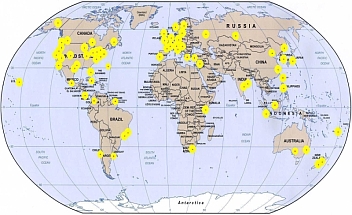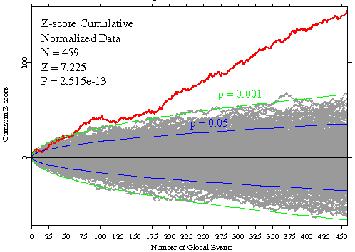The Global Consciousness Project: a Summary
The GCP was created in 1997 by a group of researchers working in the boundary areas of physics and psychology. It has grown to include over 100 scientists, artists, and others around the world. Our purpose is to study indications of the subtle reach of human consciousness in the physical world on a global scale. We maintain a network of physical random number generators (RNG) designed for and used in research showing human consciousness can affect random systems under controlled conditions. The hypothesis of the GCP is that continuous streams of data from these instruments will show anomalous deviations associated with global events that produce a large-scale, widely synchronized sharing of emotional reactions. During the first few years of the Project, the number of sites hosting our instruments grew to the present number of about 65, with locations from Alaska to Fiji, on all populated continents and in nearly every time zone. The map below left shows their locations.
We have registered over 450 formal experiments as of early 2014. Each is specified a priori as a period of time during which we predict that the data will depart from expectation based on standard statistical measures. We assess a variety of events such as the celebration of New Years, shocking events like the disaster on September 11 2001, natural tragedies such as the great earthquakes in Turkey and Haiti, the Asian and Japanese Tsunamis, and large-scale meditation and religious events like the Kumbh Mela in India. The results indicate strong correlations in some cases and virtually none in others, but overall they show significant evidence that something remarkable happens when we all are drawn into a community of interest and emotion. We have a hypothesis registry that records details of the cases we analyze, and our project's website has complete information about its history, technology, and methods, as well as free public access to the database.
The Results page gives an up-to-date summary of the formal tests, and published articles give details about the research findings, including multiple indicators of structure in data that should be random. A composite across all the individual cases can be visualized in a chronological graph that shows the steady accumulation of differences of the formal data from expectation (below right). If there were no effect, the jagged line representing the results would have a level trend, though it would wander randomly up and down near the horizontal zero line. As the figure shows, the actual data have a fairly steady upward trend. The composite statistic for the project, after 15 years of data accumulation, shows a 7-sigma departure from expectation, indicating a probability on the order of 1 in a trillion that the correlation of our data with global events is merely a chance fluctuation.
The data also show patterns in measures other than the preplanned formal statistic, which looks at network variance. This measure can be represented as a non-zero pairwise correlation of the geographically separated RNG devices. A second, orthogonal correlation also has been identified, as well as both spatial and temporal structure. The pairwise correlation effect is greater for large events than small events, and the correlation strength declines with increased separation in the small event subset. The anomalous effects also show a form of diurnal variation, with larger effects when people are awake.
These findings can't be taken as proof of an awakening global consciousness, but it is suggestive, and we have excluded reasonable mundane explanations such as electromagnetic radiation, excessive strain on the power grid, or mobile phone use. We don't yet know how to explain the correlations between events of importance to humans and the GCP data, but they are quite clear. They suggest something akin to the image held in almost all cultures of a unity or oneness, based on an interconnection that is fundamental to life. Our efforts to understand these complex and interesting data may contribute insight into the role of mind as a creative force in the physical world. We can hope they will encourage awakening to conscious evolution.


and control series
